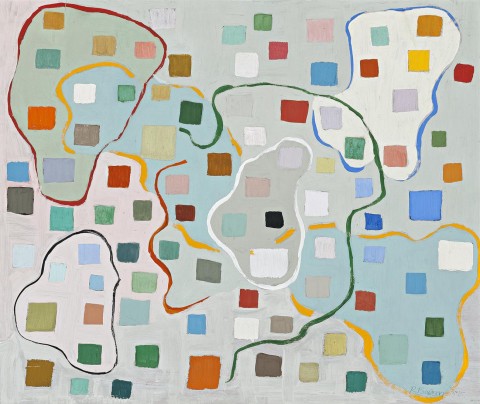CONSTRUCTIVE PAINTING, 1955
RALPH BALSON
oil on composition board
50.5 x 60.5 cm
signed and dated lower right: R Balson 55.
bears inscription on Gallery A label verso signed by Max Hutchinson: Cat.30 / RALPH BALSON / 1955.
Gallery A, Sydney (label attached verso)
Alan and Nola Geddes, Sydney
Estate of Nola Geddes, Sydney
Ralph Balson Second Memorial Exhibition, Gallery A, Sydney, 18 July 1968, cat. 30
Australian Paintings 1936 – 1976, A Collection, Ray Hughes Gallery, Brisbane, 29 May – 18 June 1981, cat. 8 (illus. in exhibition catalogue, as ‘Non Objective painting, 1955’)
Propelled by a mysterious quest to illustrate the ‘forces beyond the structure’1 of abstract painting, Ralph Balson’s formalist oeuvre evolved through a series of three separate chapters: ‘constructive paintings’ characterised by a rigorous geometry, then ‘non-objective paintings’ with fractured all-over painterly surfaces, and finally ‘matter paintings’ whose appearance was entirely governed by the inherent physical properties of poured paint. A well-read and intellectual artist, Balson made paintings that were nourished by scientific and philosophical theories on modernity, representation and the universe. A precocious disciple of international Modernist theory, Balson focused on the planar quality of the picture’s surface, producing some of the first purely abstract works in Australia.2
For Balson, non-objective painting, one that is removed from representational prerequisites, was the new frontier. It was for him, the only mode of visual expression that could adequately express the modern condition and provide a transcendental glimpse into the pure laws of nature inherent in both science and art. Constructive Painting, 1955, is a late example of Balson’s planar formalist works, another example from this year is held in the collection of the National Gallery of Australia. This painting is liminal, poised on the aesthetic frontier between the artist’s constructive logic and the painterly dissolution of his subsequent non-objective series, the first examples of which appeared this same year.
1955 was a watershed year for Balson. Having turned 65, he retired from his house-painting business, devoting his days, for the first time, to either teaching art (at East Sydney Technical College) or creating it himself. Following the first unsuccessful group exhibition of abstract works at David Jones’ Gallery in 1939, Balson and his colleague, Grace Crowley, continued their investigations independently, working alongside each other in the latter’s Mittagong home from 1954. In 1955, having worked for some years in this environment steeped in the most recent theories of international art, Balson wrote to Michel Seuphor, a Belgian artist compiling a book on Abstract art, to express both his filiation with the artist Piet Mondrian but also to express his sentiment that art should elucidate the ‘mystery and rhythm of the spectrum, and that means existence of life itself’.3
The surface of Constructive Painting features a series of simple squares of almost uniform shape and size, existing independently of each other, not overlapping, but suspended in space. We also see dissolving boundaries of form and fields of colour. Both of these elements featured very rarely in Balson’s constructive paintings, and were key stylistic developments leading towards his tachiste non-objective works.4 Surprisingly, what links these imprecise squares scattered across the picture plane is a meandering series of brightly coloured lines woven into the composition, breaking the otherwise grid-like composition. The brushstrokes of these lines and of the painterly tonal background contain the trace of the artist’s hand, marking a gestural break in his philosophy of mathematical self-effacement. Balson was now released from the impersonal and serene rigour of his former geometry, and henceforth allowed himself to embrace the ever-changing fluidity of the universe.
1. The artist, in a letter to Michel Seuphor, cited in Adams, B., ‘Metaphors of Scientific Idealism: The theoretical background to the paintings of Ralph Balson’ in Bradley, A. and Smith, T. (eds), Australian Art and Architecture: Essays presented to Bernard Smith, Oxford University Press, Melbourne, 1980, p. 188
2. Anne Dangar, a former colleague permanently residing at Albert Gleizes’ colony at Moly-Sabata, sent Grace Crowley hand written notes of the French artist’s modernist theories. Balson had access to these letters from the mid-1950s. Furthermore, Robert Klippel brought recent developments in these theories home with him from France in 1951, relating them to both Crowley and Balson. Adams, B., op cit., p. 186 and Thomas, D., ‘Ralph Balson and Gallery A’, Gallery A Sydney 1964 – 1983, Campbelltown Arts Centre, New South Wales, 2009, p.109
3. The artist, in a letter to Michel Seuphor, cited in Adams, B., op. cit.
4. Thomas, D., ‘Ralph Balson’, Art and Australia, Sydney, vol. 2, no. 4, Autumn 1965, pp. 257 – 258
LUCIE REEVES-SMITH
